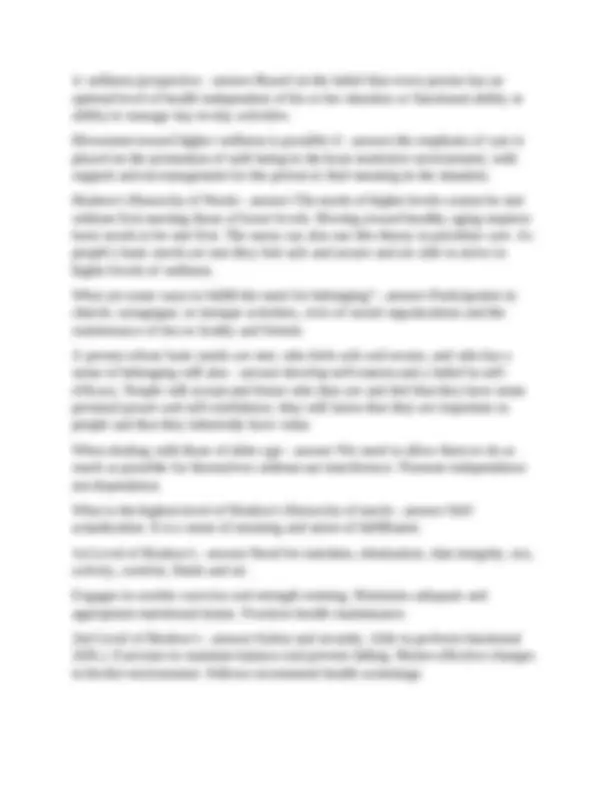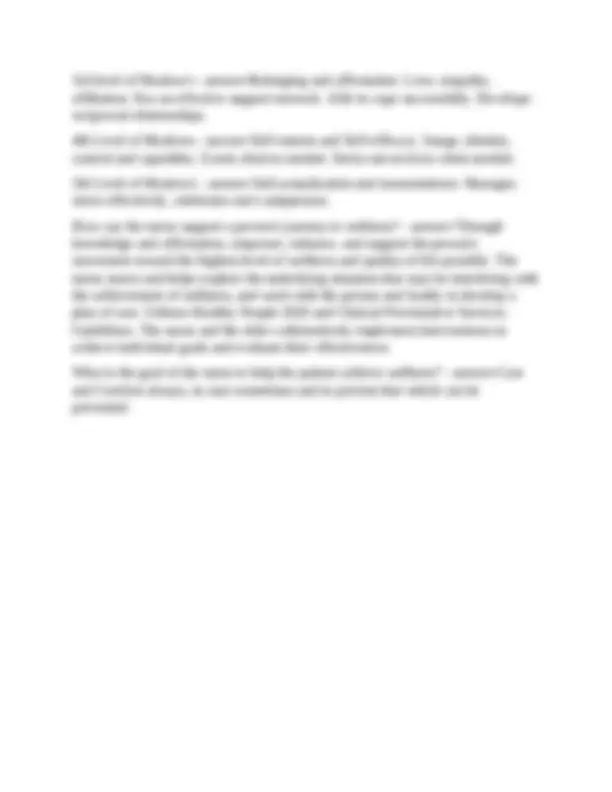




Study with the several resources on Docsity

Earn points by helping other students or get them with a premium plan


Prepare for your exams
Study with the several resources on Docsity

Earn points to download
Earn points by helping other students or get them with a premium plan
Community
Ask the community for help and clear up your study doubts
Discover the best universities in your country according to Docsity users
Free resources
Download our free guides on studying techniques, anxiety management strategies, and thesis advice from Docsity tutors
An introduction to healthy aging, covering key concepts such as cohorts, wellness, centenarians, and holistic health care. It explores the societal and cultural influences on aging, the growing elderly population, and the importance of cultural competence in healthcare. The document also delves into maslow's hierarchy of needs and its application to gerontological nursing, emphasizing the promotion of well-being and independence in older adults.
Typology: Exams
1 / 4

This page cannot be seen from the preview
Don't miss anything!



Definition of Cohort - answer-A group in which members share some common experience Definition of Wellness - answer-A state of health that is optimal for the individual person at any point in time. It is also based on where one is on the lifespan. D Definition of Centenarian - answer-A person who is at least 100 years of age. Definition of Holistic Health Care - answer-That which considers the whole person and the interaction with and between the parts. Physical, emotional, mental and spiritual components. The meaning of aging and those who are identified as elders are determined by - answer-society and culture and influenced by history and gender. The US society has determined those who are older as - answer-being 65 years of age when you become eligible for social security and retirement benefits. Definition of supercentenarians - answer-Those who are 110 years or older. Expected growth of older adults in the US - answer-By 2030 19% of the population or 72.1 million older adults are expected. Based on what year you were born each cohort had different life experiences and challenges. Each cohort is to be treated - answer-uniquely and differently. Who lives longer men or women? - answer-Women usually live longer than men and live alone after widowhood. Men who survive their wives often remarry and live alone significantly less often than women. Women usually have larger social networks outside the work environment than men, which could potentially reduce social isolation after the death of a spouse or companion. Gerontological explosion - answer-Sharp increase in those over 65 including those of diverse ethnic origins. Ethnic minorities are becoming ethnic majority.
Ethnic groups that are expected to increase in the US by 2050 - answer-Blacks, Asian, Hispanics and other races. Whites are expected to decrease in proportion to other ethnicities. Disparities in major health indicators between white and nonwhite groups are - answer-Growing What is needed to meet the needs of rapidly growing, ethnically diverse elderly populations - answer-Increasing the number of health care providers from different cultures as well as ensuring cultural competence for all. Before the year 2050, the number of persons 60 years of age and older worldwide is likely to exceed those younger than 15 years for the first time in history. How does this affect care? - answer-Poses major challenges in meeting the needs of the aging global community as the number of younger adults providing care and financial support diminishes. Dunn's Definition of holistic approach to health - answer-An integrated method of functioning which is oriented toward maximizing the potential of which the individual is capable of within the environment where he or she is functioning. It involves achieving a balance between one's internal and external environment and one's emotional, spiritual, social, cultural, and physical processes. Wellness is a state of - answer-being and feeling that one strives to achieve through effective health practices. An individual must work hard to achieve wellness. In working toward wellness, an individual may reach plateaus in his or here journey. The person may also regress because of an illness or acute event or crisis, but these events can be a potential stimulus for growth. Definition of health in later life - answer-though of in terms of functional ability (ability to do what is important to a given person) rather than the absence of disease. Well-being for those older than 60 is strongly related to - answer-functional status but is affected also by socioeconomic factors, degree of social interaction, martial status, and aspects of one's living situation and environment. What are the benefits of approaching aging from a viewpoint of health even if the person has an illness - answer-It emphasizes strengths, resilience, resources, and capabilities rather than focusing on existing pathological conditions
3rd level of Maslow's - answer-Belonging and affirmation. Love, empathy, affiliation. Has an effective support network. Able to cope successfully. Develops reciprocal relationships. 4th Level of Maslows - answer-Self-esteem and Self-efficacy. Image, identity, control and capability. Exerts choices needed. Seeks out services when needed. 5th Level of Maslow's - answer-Self-actualization and transcendence. Manages stress effectively, celebrates one's uniqueness. How can the nurse support a person's journey to wellness? - answer-Through knowledge and affirmation, empower, enhance, and support the person's movement toward the highest level of wellness and quality of life possible. The nurse assess and helps explore the underlying situation that may be interfering with the achievement of wellness, and work with the person and family to develop a plan of care. Utilizes Healthy People 2020 and Clinical Preventative Services Guidelines. The nurse and the elder collabortively implement interventions to achieve individual goals and evaluate their effectiveness. What is the goal of the nurse to help the patient achieve wellness? - answer-Care and Comfort always, to cure sometimes and to prevent that which can be prevented.